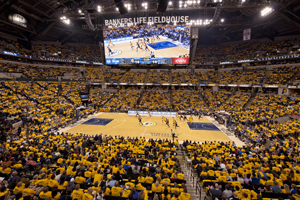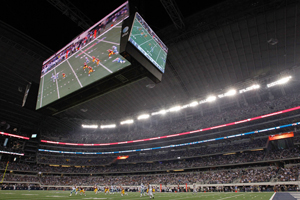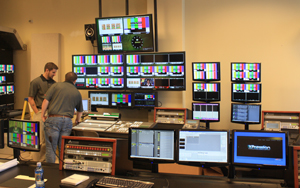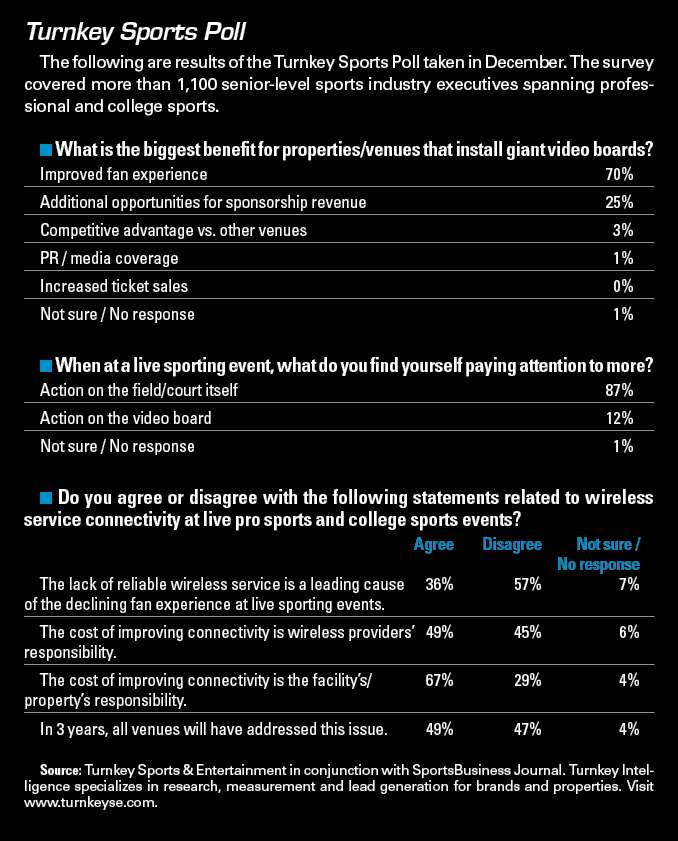Four seasons after Cowboys Stadium opened with its massive, center-hung video board, sports venues across the country are seeing the big picture themselves.
■ In Indianapolis, the Pacers have installed a center-hung board featuring twin screens stretching 50 feet along both sidelines.
■ The Houston Rockets installed an even longer board at Toyota Center, with sideline screens extending 58 feet wide.
■ At the Tampa Bay Times Forum, the Lightning’s monster board of similar dimensions will soon debut now that the NHL lockout has ended.
■ The Seattle Mariners are going through a scoreboard retrofit at Safeco Field that will become Major League Baseball’s largest single-screen video display by more than 2,600 square feet.
 |
The screens on the Indiana Pacers’ video board stretch 50 feet along the sidelines.
Photo by: Indiana Pacers |
The Houston Texans. Denver Broncos. Tennessee Titans. Charlotte Motor Speedway. The list goes on as more teams and facilities see bigger as better and a necessary part of improving the fan experience.
But not everyone is enamored with the trend. Some see the giant video boards as overkill and in some cases distracting to fans who spend more time looking at the screens than at the action on the field or court. And while the boards can add or enhance sponsorship inventory, they aren’t always a revenue stream capable of covering the cost of the technology.
Still, this trend shows little sign of fading.
‘That’s what fans demand’
What’s driving the trend to go XXXL? Competing against home theater systems remains top of mind for big league teams and colleges striving to improve the fan experience at their facilities so they can keep seats filled.
Sagging attendance across the board in most sports has teams, venues and other property owners turning to the centerpiece of their buildings to improve that portion of the game-day experience for the sports spectator who can now purchase an 80-inch television at Costco.
“It’s definitely a trend in the sense that when you buy a flat-screen at home it’s not like you say ‘I wish I bought a smaller one,’” said Steve Hellmuth, NBA Entertainment’s executive vice president of operations and technology.
“A stadium is sort of like an amusement park,” said Todd Stih, Mitsubishi Electric’s national sales manager. “You need to have a new ride every year to keep the fans coming back, and what’s going on with scoreboards is part of that.”
Panasonic produced the video board the Mariners are installing at Safeco Field. The company also built the giant
 |
The Dallas Cowboys launched the giant-screen craze when they opened their new stadium in 2009.
Photo by: Getty Images |
high-definition TV along the backstretch at Charlotte Motor Speedway. Since 2011 when Panasonic flipped the switch on the speedway project, a screen measuring 200 feet long and 80 feet high, the company has entered talks with other NASCAR tracks for similar installs, said Jim Doyle, president of Panasonic Eco Solutions North America.
“Teams want bigger boards because that’s what fans demand,” Doyle said. “You go home at night and turn on your 65-inch TV and the picture is crystal clear in HD. You go to a stadium and look up and say ‘Hey, that doesn’t look good.’ And teams hear that.”
Along the way, advancements in LED technology enable teams to replace older boards and dated technology with vastly superior models and much larger screens.
Depending on quality, some video boards turn obsolete after five to seven years of use, said scoreboard consultant Michael Rowe. The Pacers squeezed 13 seasons out of their original center-hung video board before buying a new board, said Rick Fuson, the team’s chief operating officer.
WHAT OTHERS ARE SAYING
“I’m not knocking the Cowboys, but I’ve gone to that stadium several times and looked at it. I would have done that board 20 percent to 30 percent smaller and used a higher resolution pixel. I know Jerry Jones thought bigger is better and that’s the way it is.”
— Michael Rowe
Scoreboard consultant,
Anthony James Partners
“There’s been this idea of having a bigger screen than in your home, but that [experience] is free. The joy of tailgating, forming bonds with family and friends, sitting shoulder to shoulder in the stadium, that’s where we win the battle.”
— Jamey Rootes
President,
Houston Texans
“There are traditionalists. Look at Notre Dame. They don’t like to go digital. Is it too much of a good thing? You need to find the right balance.”
— Jay Parker
National sales manager, Daktronics
“I can see the day when DirecTV puts the NFL Mix Channel, eight different games, on the big screen.”
— Jerry Cifarelli
President and CEO,
ANC Sports
“I told [team owner] Mark Attanasio, ‘We need to spend millions on a new board but I can’t guarantee more sponsorship money and it might not bring one more fan to the park.’ It has helped sponsorships, but from a pure ROI standpoint, it’s not going to pay for the board.”
— Rick Schlesinger
Chief operating officer,
Milwaukee Brewers
“What keeps me up at night is making sure we have time to train everybody on the new equipment and it’s up and running come April 8 for Opening Day.”
— Kevin Martinez
Vice president of marketing,
Seattle Mariners
The Mariners are replacing the original board at Safeco Field, a ballpark that opened in July 1999 about three months before the Pacers’ arena did. It is the final piece of a three-phase project covering a new out-of-town scoreboard and new LED ribbon boards.
For those in the market for an upgrade, their money goes much further now as the expenses for larger screens fall in line with the costs of smaller boards 10 years ago when LED was relatively new, say scoreboard manufacturers.
Surface mount technology, the latest evolution in video boards, has higher resolution, brighter colors and expanded viewing angles. It started with indoor boards and has moved outdoors over the past few years as scoreboard makers have resolved the issue of protecting higher-end screens from rain and sunlight.
This past season, the Tennessee Titans were the first NFL team to install a surface-mount system with two end zone displays measuring 157 feet wide and 54 feet high. The Mariners’ new center-field screen is a surface mount unit.
“Everything is moving to SMT the next few years,” said Rowe, a principal with Anthony James Partners, a Richmond, Va., firm hired by big league teams and colleges to help find the best possible video boards for their facilities.
Competing for special events is also driving the trend. In the NFL, the Houston Texans and Denver Broncos are replacing original video boards this offseason with much larger screens with an eye toward landing future Super Bowls.
At Reliant Stadium, the Texans recently one-upped the Cowboys, their in-state rival, by announcing plans to install the two largest video boards in pro team sports. When they power up in August, the Mitsubishi Electric end zone displays will be 25 percent bigger than the sideline screens at Cowboys Stadium.
The Texans are sharing the $16.5 million cost with the Houston Livestock Show & Rodeo, their co-tenant, and the county. The Broncos’ new screens, part of $30 million in stadium improvements, will be three times larger than the old boards at Sports Authority Field at Mile High.
“The trend won’t go away,” said Rockets CEO Tad Brown. “For us, it was how do you create an experience that makes you feel more a part of the game? There was some debate internally about [its size]. We decided the wow factor for fans at all levels would put us over the top.”
Texas-sized competition
In Houston, the competition for best scoreboard has ramped up at every sports venue in the city.
Besides the Rockets, the Texans are playing catchup with the Astros, who last year installed MLB’s third-largest video board at Minute Maid Park, and BBVA Compass Stadium, which opened in May as the new home of Major League Soccer’s Houston Dynamo. In addition, the University of Houston will open a new college football stadium in 2014 that will most likely showcase the latest scoreboard technology.
Darrell K Royal-Texas Memorial Stadium in Austin, home of University of Texas football, has a giant end zone screen dubbed “Godzillatron.” For the past seven seasons, Longhorns fans, many of whom also attend Texans games, have grown accustomed to watching live game action and replays on a larger-than-life screen.
As the Texans upgrade a stadium that has sold out every game since it opened in 2002, their fans have been patient and “don’t shake their fists on the table” demanding new video screens, said Texans President Jamey Rootes.
“The quality of our presentation, even on an 11-year-old board, has been tremendous,” Rootes said. “Moving forward, we will have a massive canvas to paint on.”
Across town, the Rockets had planned to upgrade their board next season as a tie-in to Toyota Center’s 10th anniversary but decided to buy the equipment one year early in time to showcase the new screens for next month’s NBA All-Star Game in Houston. Three months into the regular season, multiple NBA teams have visited the arena to see the board or have called the Rockets to learn more about the project and its benefits, Brown said.
Here’s what the Rockets are telling them: Through early January, their home attendance was up roughly 20 percent over last season, with the new board serving as a “major focal point” for drawing more fans to the arena, Brown said. The Rockets have also seen about a 15 percent bump in total bowl signage revenue with more assets to sell, including new LED displays on the basket stanchions and entrances to the seating bowl behind the baskets.
Next season, the Rockets expect that signage revenue number will rise another 30 percent as they get more comfortable operating the new board’s technology. “As we figure out how to program it better, it will boost the value of existing and new deals,” Brown said.
The Rockets’ situation falls in line with the learning curve all teams face as they move from “selling real estate to selling air time” on newer boards where the entire structure can be programmed with live video, Rowe said.
“The people who have sold that inventory are used to selling static sign positions,” he said. “Now, [for instance] Jerry’s Tires is going from a fixed sign to a spinning tire rolling across the screen four times a game. It’s a difficult transition and that’s where it’s really an education.”
But with that education comes opportunities to sell more sponsorships tied to full-screen video compared with installing a static sign. It’s simpler and less costly, too.
At Safeco Field, for example, team sponsor Pepsi can now send the Mariners a computer file to change its message for the month of July. For the old board, it might have cost the Mariners $10,000 to pay somebody to go to the park and set up scaffolding to switch a fixed ad panel, said Joe Chard, the team’s vice president of corporate business and community relations.
“We’re going from a little [video] box that we used to have on the main scoreboard to this enormous LED board,” Chard said. “We have some things we’re talking to different [sponsors] about that we’ve never had the opportunity to do before.”
A new video board may improve the fan experience and provide dynamic advertising options, but it doesn’t guarantee teams a large chunk of incremental revenue.
In MLB, where clubs are restricted in the content they can show during the game, sponsorship income alone does not cover the investment, said Rick Schlesinger, the Milwaukee Brewers’ chief operating officer. In 2011, the Brewers introduced a new $10 million video board at Miller Park and have seen small percentage increases in sponsor dollars as opposed to large multiples, Schlesinger said.
“There is a limit to inventory and video and we need to toe the line,” he said. “Fans understand; it’s more than just a commercial.”
Not everyone’s sold
Despite the trend in monster boards, some people believe that going gargantuan doesn’t necessarily translate to a better fan experience. That includes Rowe, the consultant and a former sales manager with Lighthouse Technologies, a leading manufacturer of LED boards.
Anthony James Partners recently signed deals with the Phoenix Suns and the Utah Jazz to guide them through the
 |
Inside the video control room at Lambeau Field. Teams such as the Green Bay Packers can use the new systems to quickly change sponsor messaging.
Photo by: Anthony James Partners |
process for upgrading their center-hung boards, and Rowe won’t shy away from telling those NBA teams that he believes some clubs have already gone past the tipping point with monster boards.
“Indoors, the screens are so overpowering; instead of quality they’re going for size,” Rowe said. “There’s no design style, they’re not really thinking about how they’re being used, and that’s one area that needs to be improved. They’re [the teams] building these huge units but don’t understand how to use the content and that’s a real struggle. There’s a common sense approach that gets a bit lost when the vendors take control. We push for higher design with better-looking finishes and signs.”
The key is matching the size of the board to the experience and wrapping all the elements together that make up a live sports event, Doyle said. For example, there was a purpose for going huge at Charlotte Motor Speedway, where the viewing distances are massive at a racetrack with 160,000 seats.
“Before they had the board, if you weren’t a NASCAR fan and walked into the track, outside of that one pole [listing driver numbers], who’s in the lead?” Doyle said. “You don’t know. But now you get all that information [on the video board] you would get during the race on Fox or ESPN.”
Doyle agreed with Rowe that there is a limit to the size of the scoreboard before it begins to “take away from the action.” Cowboys Stadium’s center-hung board “is so big, it’s almost distracting,” he said.
Say what you will about Jerry World but its influence can’t be denied. B.C. Place in Vancouver, an indoor stadium, installed a center-hung board as part of a $570 million renovation completed in 2011, a project Rowe worked on. Look at the most recent renderings of the new Minnesota Vikings stadium and one image shows a center-hung board, although team officials have not made a final decision on where the board will be situated, said Lester Bagley, the team’s vice president of public affairs and stadium development.
HKS, the firm that designed Cowboys Stadium, is also designing the Vikings’ new stadium.
In 2009, Cowboys Stadium opened with the NFL’s first center-hung video board, an engineering marvel stretching 60 yards between the 20s.
“The scoreboard has really sort of defined who we are,” said Charlotte Jones Anderson, a Cowboys executive vice president and daughter of team owner Jerry Jones. “When our fans come here, they’re obviously giving up everything they had at home, so it’s incumbent upon us to deliver that special experience. What we’ve been able to do, by things such as getting right into the players’ eyes, is create a real level of engagement with the board.”
When the Pacers were planning to buy a new board, team owner Herb Simon mentioned the possibility of adapting the Cowboys Stadium design on a smaller scale to fit the arena. “The idea stuck and we worked with ANC on a design with a curved board,” Fuson said.
Some would question how the monster board ties in with the facility’s theme as the NBA’s first retro arena, but Fuson points to new LED ribbon boards and a premium club along one baseline as upgrades that did not change the feel of an arena marketed as a vintage fieldhouse.
“When we built the arena we had a video board and it’s not like we were keeping score with chalk and flip-over scoreboards,” Fuson said. “Now, we’re going with something bigger and more up to date. It has not taken away from the charm of the arena.”







